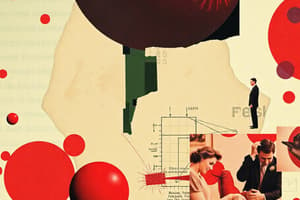Podcast
Questions and Answers
Hemoglobin is a protein responsible for oxygen ______ in red blood cells.
Hemoglobin is a protein responsible for oxygen ______ in red blood cells.
transport
Each hemoglobin molecule can bind up to four ______ molecules.
Each hemoglobin molecule can bind up to four ______ molecules.
oxygen
Erythropoiesis is the production of red blood cells in the ______.
Erythropoiesis is the production of red blood cells in the ______.
bone marrow
The hormone ______, produced by the kidneys, stimulates RBC production.
The hormone ______, produced by the kidneys, stimulates RBC production.
RBCs transport oxygen from the lungs to body ______.
RBCs transport oxygen from the lungs to body ______.
RBCs help maintain blood ______ and volume.
RBCs help maintain blood ______ and volume.
RBCs can influence the immune response via the release of signaling ______.
RBCs can influence the immune response via the release of signaling ______.
Despite lacking a nucleus, RBCs can present some ______ to the immune system.
Despite lacking a nucleus, RBCs can present some ______ to the immune system.
Flashcards are hidden until you start studying
Study Notes
Red Blood Cells (RBCs)
Hemoglobin Function
- Primary Role: Hemoglobin (Hb) is a protein in RBCs responsible for oxygen transport.
- Oxygen Binding: Each hemoglobin molecule can bind up to four oxygen molecules, forming oxyhemoglobin.
- CO2 Transport: Hemoglobin also aids in the transport of carbon dioxide (CO2) from tissues to lungs.
- pH Buffering: Hemoglobin helps maintain blood pH by buffering changes in acidity.
Erythropoiesis Process
- Definition: Erythropoiesis is the production of red blood cells in the bone marrow.
- Stimulating Hormone: Erythropoietin, produced by the kidneys, stimulates RBC production in response to low oxygen levels.
- Stages of Development:
- Proerythroblast: Immature precursor cell.
- Basophilic Erythroblast: Produces more hemoglobin.
- Polychromatic Erythroblast: Further hemoglobin synthesis, cell starts to shrink.
- Orthochromatic Erythroblast: Nucleus is ejected, cell becomes a reticulocyte.
- Reticulocyte: Immature RBC released into circulation, matures into erythrocyte in 1-2 days.
- Lifespan: RBCs typically live about 120 days before degradation.
Blood Circulation Role
- Oxygen Delivery: RBCs transport oxygen from the lungs to body tissues.
- Nutrient Transport: They assist in transporting nutrients and waste products throughout the body.
- Regulation of Blood Volume: RBCs contribute to maintaining blood viscosity and volume.
- Movement: RBCs are flexible, allowing them to navigate through capillaries effectively.
Immune System Interaction
- Immune Response: RBCs can influence the immune response indirectly via the release of signaling molecules.
- Antigen Presentation: While RBCs lack a nucleus and major histocompatibility complex (MHC), they can present some antigens to the immune system.
- Infection Response: Certain pathogens can target RBCs, leading to anemia or other complications.
- Role in Inflammation: RBCs can participate in inflammatory responses through interactions with immune cells.
Red Blood Cells (RBCs)
Hemoglobin Function
- Hemoglobin is the primary protein in RBCs, facilitating oxygen transport throughout the body.
- Each hemoglobin molecule can bind with up to four oxygen molecules, creating oxyhemoglobin for efficient oxygen delivery.
- Hemoglobin plays a dual role by also transporting carbon dioxide from body tissues back to the lungs.
- It contributes to blood pH regulation by acting as a buffer against acid-base changes.
Erythropoiesis Process
- Erythropoiesis refers to the formation of red blood cells in the bone marrow.
- Erythropoietin, a hormone produced by the kidneys, triggers RBC production in response to decreased oxygen levels in the blood.
- Development Stages:
- Proerythroblast: An immature precursor cell marking the first stage.
- Basophilic Erythroblast: This stage sees increased hemoglobin synthesis.
- Polychromatic Erythroblast: Cell shrinks further while continuing hemoglobin production.
- Orthochromatic Erythroblast: The nucleus is expelled, creating a reticulocyte.
- Reticulocyte: An immature RBC that enters circulation and matures into a fully functional erythrocyte within 1-2 days.
- RBCs generally have a lifespan of about 120 days before being broken down.
Blood Circulation Role
- RBCs are responsible for delivering oxygen from the lungs to various body tissues.
- They help in the transport of nutrients and the removal of waste products from the body's cells.
- RBCs aid in regulating blood volume and viscosity, contributing to overall circulatory health.
- Their flexible structure enables them to navigate efficiently through narrow capillaries.
Immune System Interaction
- RBCs can indirectly modulate the immune response by releasing signaling molecules.
- Although RBCs lack a nucleus and major histocompatibility complex (MHC), they can still present some antigens to the immune system.
- Pathogens may target RBCs, which can result in complications such as anemia.
- RBCs also engage in inflammatory responses through interactions with various immune cells.
Studying That Suits You
Use AI to generate personalized quizzes and flashcards to suit your learning preferences.




